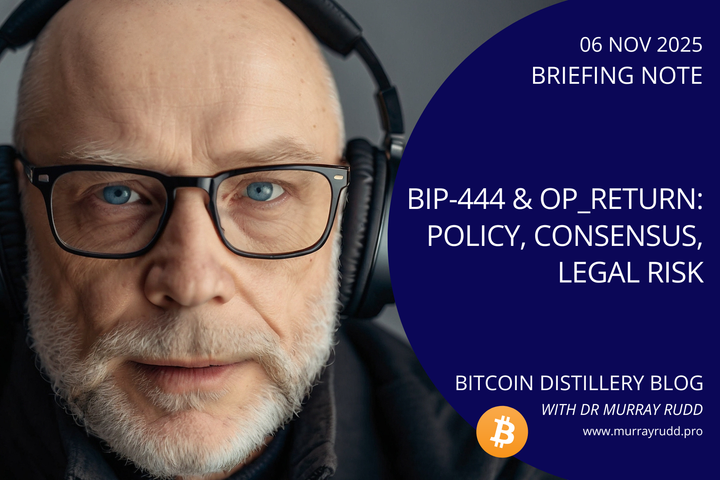BIP-444, Neutral Blockspace, and Bitcoin Fork Risk
The November 06, 2025 episode of Supply Shock features a panel assessing BIP-444’s attempt to restrict certain data patterns through a time-limited Bitcoin soft fork.

Briefing Notes contain: (1) a summary of podcast content; (2) potential information gaps; and (3) some speculative views on wider implications for Bitcoin. Most summaries are for Bitcoin-centered YouTube episodes but I also do some on AI and technological advance that spill over to affect Bitcoin.
Summary
The November 06, 2025 episode of Supply Shock features a panel assessing BIP-444’s attempt to restrict certain data patterns through a time-limited Bitcoin soft fork. The panel evaluates enforceability limits, scope creep into Taproot, and governance risks that echo the block size wars. Participants weigh activation paths, miner and exchange behavior, and market signals to estimate the odds and consequences of a contentious change.
Take-Home Messages
- User spend protection: Time-limited restrictions can delay or invalidate existing spend paths, creating material user lockout risk.
- Enforcement reality: Filtering specific encodings likely shifts activity to new formats rather than eliminating it.
- Scope discipline: Broad rules risk collateral damage to Taproot trees and second-layer designs, chilling R&D.
- Consensus before code: UASF/URSF (User Activated Soft Fork/User Rejected Soft Fork) dynamics and reorg asymmetries make social alignment the binding constraint.
- Follow the plumbing: Miner signaling, exchange treatment, and market-implied odds are the most reliable activation indicators.
Overview
The discussion centers on BIP-444, framed as a temporary soft fork aimed at curbing specified on-chain data patterns associated with non-monetary uses. Panelists argue that the proposal could freeze certain spend paths for a defined period and disrupt users who relied on current script behaviors. This immediately reframes the issue from nuisance filtering to direct interference with property rights embedded in spend conditions.
Several speakers contend that arbitrary-data filtering is not durable because practitioners will switch to alternative encodings. If new encodings replicate the same effect, the net result is displacement rather than reduction in activity. Users, however, bear new operational costs through broken scripts, delayed access, and compatibility headaches.
Concerns intensify around scope, with attention shifting from OP_RETURN toward Taproot script paths and constructions such as BitVM. The panel warns that ill-defined or broad rules could clip legitimate functionality and slow second-layer experimentation. This risk profile turns a narrow nuisance fix into a wider governance hazard for innovation.
Governance and market structure take center stage as the group revisits block size war precedents. Activation pathways through UASF and URSF are dissected, including how reorg asymmetries and checkpointing tactics influence incentives. Supply Shock is used to surface external barometers like prediction markets and proposed on-chain wagers, with low implied odds tempering expectations of near-term activation.
Stakeholder Perspectives
- Miners: Seek clear incentives and minimal legal or reputational exposure; avoid leading contentious changes without broad alignment.
- Node Operators: Prioritize predictable validation rules and oppose proposals that freeze previously valid spend paths.
- Exchanges and Custodians: Focus on deposit/withdrawal continuity, chain selection, and finality guarantees during activation windows.
- Wallet and L2 Developers: Protect Taproot flexibility and second-layer roadmaps; fear regressions that force redesigns or centralizing workarounds.
- Policy and Regulators: Monitor systemic risk from governance disputes and their effects on consumers and market stability.
Implications and Future Outlook
A push for BIP-444 without broad buy-in will likely trigger defensive coordination rather than smooth activation. Expect contingency planning around URSF narratives, checkpoint talk, and operational runbooks for infrastructure providers. In this environment, code proposals compete with legitimacy, and legitimacy remains the decisive resource.
If the proposal narrows to verifiable harms with clearly bounded scope, it may reclaim support from cautious stakeholders. Evidence-first framing and explicit non-goals would reduce fears of collateral damage to Taproot and Layer 2 research. Absent that discipline, the path of least resistance becomes non-consensus mitigations and education about neutral blockspace.
Market structure will shape outcomes as much as ideology. Miner signaling, exchange treatment, and liquidity preferences will converge on the chain that minimizes user harm and business disruption. Low market-implied odds of activation will remain a drag unless proponents demonstrate measurable benefits that outweigh coordination risk.
Some Key Information Gaps
- Under what measurable consensus thresholds should any activation proceed to minimize split probability? Clear, pre-committed thresholds reduce coordination failure and protect users from chain fragmentation.
- What concrete categories of existing spend paths would BIP-444 render invalid or delay, and at what measured scale? Quantifying affected UTXOs transforms abstract debate into concrete risk management for wallets and services.
- How effective are URSF and checkpoint strategies at preventing long-horizon reorg attempts in practice? Evidence on operational efficacy guides safe deployment of defensive mechanisms if disputes escalate.
- What is the minimal-scope change that addresses stated concerns without impairing legitimate Taproot script usage? Narrow tailoring preserves innovation while addressing the specific behavior at issue.
- How would major exchanges and custodians treat deposits and withdrawals during potential activation or split windows? Understanding operational policies determines user experience and market stability under stress.
Broader Implications for Bitcoin
Governance Legitimacy as a Scarce Resource
Legitimacy, not just code quality, determines whether network-wide changes succeed in systems like Bitcoin. Proposals that threaten user spend assumptions consume this legitimacy quickly and raise coordination costs for future upgrades. Over the next 3–5 years, governance processes that pre-commit to scope limits and measurable thresholds will become the main safeguard against fragmentation.
Neutral Blockspace vs. Content Policing
Efforts to police data content risk redefining base-layer norms from neutral blockspace sales to adjudication of use cases. That shift invites legal and compliance pressure and increases the probability that infrastructure centralizes around entities willing to filter. A sustained move toward neutrality—anchored by fee markets and clear property-rights framing—offers a more resilient path across jurisdictions.
Innovation Flight to Second Layers and Custodial Rails
If base-layer rules unpredictably constrain scripts, builders will migrate to L2, federated, or custodial environments where policy risk is lower. This migration can erode self-custodial usage and concentrate power in platforms that are easier to regulate or pressure. Designing predictable, minimal base-layer rules will be critical to keep experimentation decentralized and broadly accessible.
Market Signals as Policy Inputs
Prediction markets, on-chain wagers, and liquidity patterns can serve as early-warning indicators of social consensus and activation feasibility. Treating these signals as policy inputs helps institutions plan deposits, withdrawals, and listing policies under contested conditions. Over time, a standard practice of consulting market-implied odds could professionalize protocol change management.
Legal-Pressure Spillovers
Appeals to corporate compliance or jurisdictional threat models will not stop at one dispute; they create templates for future interventions. Once normalized, these tactics can transform technical disagreements into legal battlegrounds that discourage participation and node operation. Jurisdiction-agnostic governance norms will be necessary to keep coordination costs contained across borders.



Comments ()